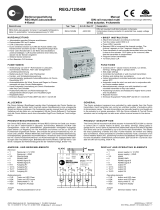
Eltako – The System in the Building – Operating manual for Series 14 RS485 bus DIN rail mounted devices 3
Technical planning guide
First, the bus system is described for activation with wireless sensors. Alternatively cable-bound activation is also possible. This is
described in detail in Chapters 7 and 8.
Series 14 devices are fitted to DIN-EN 60715 TH35 rails and their RS485 bus. They are also connected to the power supply by
jumpers. Consumers are activated centrally from a main distribution panel or several subdistribution panels.
The bidirectional FAM14 wireless antenna module is the interface between wireless sensors (e.g. pushbuttons) and all Series 14
actuator. It receives, sends and checks all signals from the wireless transmitter and repeaters within its reception range. A sub-bus
comprising up to 3 additional FEM wireless receiver modules may be added at any time to increase reception range.
Received wireless signals are passed on to downstream switch actuators via an RS485 interface in the FAM14. Up to 126 chan-
nels can be connected to each FAM14 antenna module. A flexible BBV14 bus connector or an FBA14 bus coupler permits wire
connections across several rails. The necessary 12V DC voltage supply is already included in the FAM14 and supplies all system
components and actuators up to a power output of 8W* via jumpers.
The maximum power require
ments of each connected device must be added in order to calculate the total power requirement of
the
12V DC power supply. If the power requirement is greater, an additional FSNT14-12V/12W switch
mode power supply unit must be
used for every 12 watts required. In addition, an TB14 disconnecting link must be plugged into the device instead of a standard jumper
in order to disconnect the additionally powered group.
The table below is a simple aid showing how to determine total power requirement.
Wiring recommendations:
If several loads in one room are supplied by a circuit breaker, wiring can be saved by routing NYM-J 7x1.5 or 10x1.5. The continu-
ous power supply with 3 wires and all the other 4 or 7 wires can then be used as hook-up wires.
* The switch mode power supply unit included in the FAM14 isolates the electronics of all connected devices from the 230V mains
power supply. As a result, the devices are not exposed to voltage peaks and other faults which are becoming increasingly fre-
quent on mains power supplies. This protection significantly increases the expected service life of the devices as opposed to
decentralised mounted actuators.
1. Technical planning guide Wireless Building with the Series 14
Device Maximum power requirement
(existing relay excited) Device Maximum power requirement
(existing relay excited)
BGW14 0,30 W FSB14 0,42 W
F2L14 0,14 W FSDG14 0,40 W
F3Z14D 0,10 W FSG14/1-10V 0,20 W
F4HK14 0,70 W FSM14 0,10 W
F4SR14-LED 1,00 W FSR14-2x 0,14 W
FAE14LPR 0,42 W FSR14-4x 0,70 W
FAE14SSR 0,40 W FSU14 0,14 W
FDG14 0,40 W FTD14 0,53 W
FFR14 0,63 W FTN14 0,14 W
FGSM14 0,20 W FTS14EM 0,13 W
FGW14 0,50 W FTS14FA 0,50 W
FGW14-USB 0,30 W FTS14GBZ 0,10 W
FHK14 0,42 W FTS14TG 0,42 W
FMS14 0,63 W FUD14 0,20 W
FMSR14 0,10 W FUD14/800W 0,20 W
FMZ14 0,40 W FWG14MS 0,30 W
FPLG14 0,40 W F WZ14- 65 A 0,10 W
FPLT14 0,40 W FZK14 0,14 W
FRP14 0,50 W






















